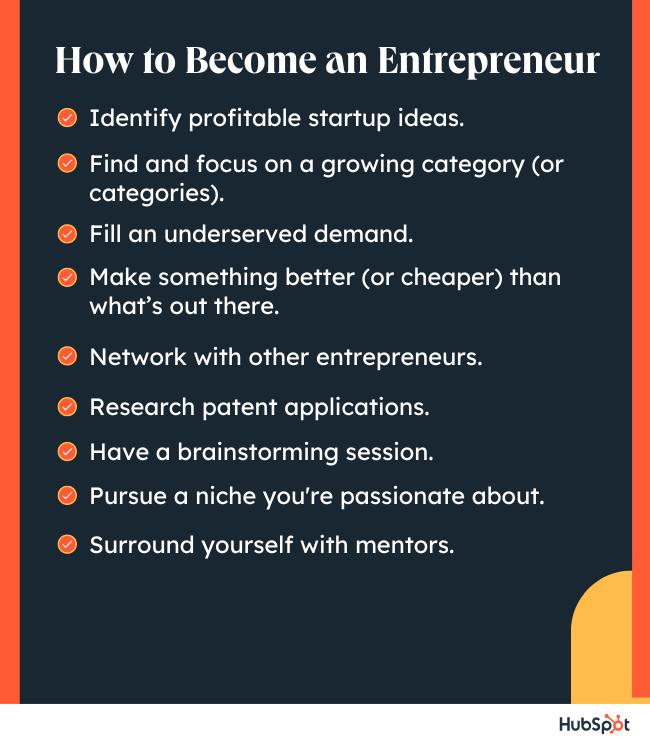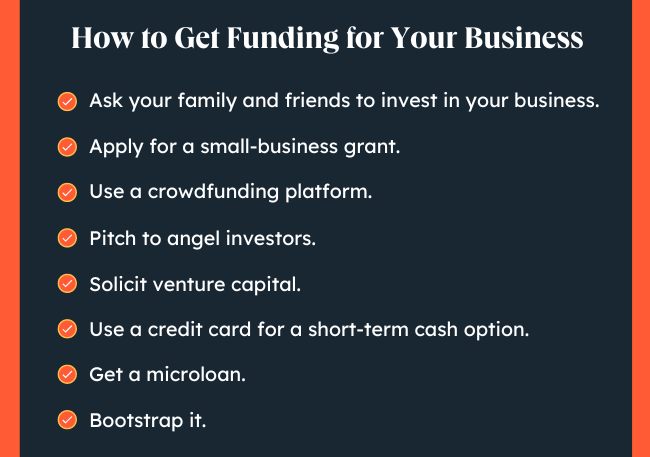Here, we'll cover:
- How to Become an Entrepreneur
- 11 Growth Tips for Entrepreneurs
- Gaining Experience as an Entrepreneur
- How to Get Funding to Start a Business
- How to Incorporate Your Business
- Help and Support for Entrepreneurs
- FAQs About Becoming an Entrepreneur
Great ideas can come from anywhere, and unmet needs often make the best business ideas. Here, we’ll share tips for brainstorming. Once you have an idea, you can start your entrepreneurship journey.
1. Identify profitable startup ideas.
This might go without saying, but every successful startup is supported by a good idea — a product or service with a compelling enough value proposition to make prospects say, “Wow! That product or service's value proposition sure seems compelling! Maybe, I'll give it a shot!”
Okay, maybe they don't say that verbatim — but the fact remains: Your startup needs to revolve around an offering (or suite of offerings) that can drum up serious interest.
And getting there starts with some solid, thoughtful contemplation and brainstorming. Here are some good places to start.
Ask your friends what frustrates them.
Founders often strike gold when they ask about their pals’ frustrations. “When you set out to build a product, it’s typically to solve an issue you’re fed up with. That’s why I teamed up with some of the same friends who were asking me to help them book party buses, and we created Swoop,” says Amir Ghorbani.
Like Amir Ghorbani, these founders got inspiration from challenges that bugged them and their friends.
- Travis Kalanick and Garrett Camp started Uber after struggling to get a cab.
- Andrew Kortina and Iqram Magdon-Ismail founded Venmo (acquired by PayPal) after they had trouble paying each other back by check.
- Chris Riccobono and Aaron Sanandres launched UNTUCKit — a line of shirts that look good untucked — after getting frustrated with how wrinkly and ill-fitting their regular button-down shirts were when they didn’t tuck them in.
As you brainstorm, ask your friends to keep track of the day-to-day things that annoy them. Go through their lists and look for problems you might be able to solve.
Get inspired by emerging startups.
Checking out the businesses of emerging startups is a great way to kick your thought process into gear. You can get ideas from Product Hunt, a constantly updated curation of the newest apps, websites, and games.
An excellent success story of this approach is Zapier.
In the words of Wade Foster, CEO of Zapier, “One day Bryan [a co-founder] texted me and said, ‘Hey, one idea that I think could be useful is to make it simple for a business user to connect the tools they’re using. You could integrate Mailchimp and Wufoo or Zendesk and Salesforce with a quick drag-and-drop click UI.’”
Lots of discussions followed. And today, Zapier is worth $5 billion.
If you’re more of a “physical products” entrepreneur, you can check Kickstarter for ideas. Product review sites like Uncrate, Werd, and Wirecutter can spark your creativity and give you ideas as well.
Identify trends to future-proof your idea.
As the world changes, people will need different products to make their lives easier. For instance, the rise of Uber, Lyft, and other ride-sharing apps created a demand for a third-party app that shows the cheapest ride fares at any moment.
You want to get ahead of the curve. Read trend predictions for your industry or market, or check out universal trend forecasting publications like Trend Hunter and Springwise. Then ask yourself, “If these predictions come true, which tools will be necessary?”
2. Find and focus on a growing category (or categories).
Licensing expert and intellectual property strategist Stephen Key recommends picking a category that fascinates you but isn’t overly competitive.
“I avoid industries that are notoriously challenging, like the toy industry. There are so many people creating in that space,” he explains. “You will have an easier time licensing your ideas if you focus on categories of products that are growing, as well as receptive to innovation.”
After you’ve picked a category, Key says you should study all the products in that category.
- What’s the benefit of each product, and how do they vary?
- What’s their packaging and marketing strategy?
- What are the potential improvements?
- What do reviewers say?
Once you’ve picked a product, consider questions like:
- What can I do to improve it?
- Can I add a new feature?
- What about a different material?
- Can I personalize it?
3. Fill an underserved demand.
Several successful businesses started with savvy entrepreneurs identifying gaps in their markets — ignored, unappreciated, or underserved audiences with legitimate purchasing power. If you can identify and accommodate that kind of demand, you'll set yourself up for success as an entrepreneur.
For example, when Laura and Kelly Moffat, self-described tomboys, were searching for clothes for their wedding, they realized it was difficult to find alternative options to a wedding dress.
Instead of leaving this as an unfixed problem, they found a solution by creating fitting clothing that makes people of the LGBTQ+ community feel comfortable and confident on their big day.
4. Make something better (or cheaper) than what’s out there.
You don’t always need to develop something brand-new. If you can offer an existing product at a lower price point, better quality, or, ideally, both, you'll have plenty of customers. Better yet, there’s clearly an existing demand.
As you go about your day, list everything you use. Then review the list for something you could improve.
5. Network with other entrepreneurs.
Use Meetup or Eventbrite to find events in the local startup community. Not only will networking with other entrepreneurs help you build valuable relationships, but also it will give you lots of ideas.
“From entrepreneur groups to tech meetups, there are a ton of ways to meet like-minded individuals and gather resources. So Google these meetups and get ready to leave the house,” says Kim Kaupe, co-founder of ZinePak.
Check out this video for some quick tips on networking efficiently and meaningfully as an entrepreneur.
6. Research patent applications.
The United States Patent and Trademark Office (USPTO) makes patent applications public 18 months after filing.
Although we don’t recommend outright copying any inventions, browsing through these documents can give you a good sense of where a particular industry is headed. Find patents by searching for a particular keyword on Google Patents.
7. Have a brainstorming session.
If you need to get your creative juices flowing, invite three to five entrepreneurial-minded people to a brainstorming session. Ask everyone to come prepared to discuss a certain product category or question, such as:
- What’s your favorite type of X, and why?
- Do you use anything to accomplish Y? Why or why not?
The answers may lead to some great ideas.
8. Pursue a niche you're passionate about.
Keira Rumble, Founder of Krumbled Foods, says, "My advice for aspiring entrepreneurs is to pursue a niche you're genuinely passionate about. Your enthusiasm will fuel your persistence and creativity, which are crucial for overcoming challenges.
"For me, the inspiration came during my pregnancy. I craved nutritious snacks but found limited options that were both delicious and beneficial for expecting mothers. This gap in the market led me to create Krumbled Foods.
"The process began with identifying the problem — healthy snacks that cater to pregnant women were scarce. I researched extensively and started small. Positive feedback then validated your ideas. From there, you can scale up.
“The key is to find a problem you're passionate about solving and commit to it wholeheartedly. Your genuine interest will drive you to create a product or service that truly stands out.”
9. Surround yourself with mentors.
Emily Dills, Founder of Seattle Nanny Network, Inc., says, "I recently began working with a well-known business coach in my industry. She has had success running her own business for over twenty years and also has a successful coaching business with clients on three continents.
"When she mentioned that she herself has a business coach, it struck me. Despite her success, she's still learning.
"My advice for aspiring entrepreneurs is to start by surrounding yourself with mentors. This is the proximity principle. Being in the company of those who are working towards, or have already achieved, success will have an undeniable impact on your own belief system.
“This can be mastermind groups, business owners turned coaches, you name it. Then, when you do achieve milestones, don't get complacent. Find an amazing coach who can help you reset and achieve even greater goals.”

11 Growth Tips for Entrepreneurs
There's no single mold that every successful entrepreneur fits, They hail from unique backgrounds with unique ideas, supported by unique motivations. Still, unique as they might be, virtually all entrepreneurs can benefit from some universally applicable growth tips.
Here are a few of those tricks and strategies you can leverage to support your business's growth.
1. Validate your startup idea with buyer persona research.
Now that you’ve got an idea, don’t quit your day job yet. Before you go all-in, ensure you have customers who want your product (your friends and family don’t count).
To do this, start by understanding your buyer persona (i.e., the real people you plan to sell to). If your product doesn’t serve a need, they won’t be interested, no matter how innovative or cool it is. That’s why buyer persona and market research are vital.
After identifying your ideal customers, interview some of them. Show them a demo of your product, ask what they like and what they don’t, how much they’d pay for it, how often they’d use it, and so on.
If you want to test the market’s interest before building anything, build a landing page that describes your product or service.
Ask people to submit their email addresses in exchange for early access; a free subscription, membership, or product; or a discount, product updates, or other compelling offers. Then promote your page on social or paid search and see how many visitors convert to sign-ups.
2. Start with a minimum viable product (MVP).
An MVP is your tool or service's simplest, most basic version. It’s functional enough to satisfy early customers and understand what you should improve.
Let’s say you want to build an app connecting college students with virtual tutors. You might create a bare-bones version, manually invite 150 tutors you found online to join, and then post the link to the app on the local university's Facebook page.
If you get a decent number of sign-ups, that’s a sign you should move forward. If you barely get any, you should rethink the idea or start fresh.
Starting small with an MVP keeps your costs low and allows room for growth as the product continues to be validated.
3. Continue to iterate based on feedback.
Your MVP will not likely be enough to stay competitive in your market categories, especially if you have big dreams for your startup.
Now comes the cycle: generating interest and demand (marketing the product), securing customers (selling the product), gauging satisfaction, improving the product based on feedback ... and repeating.
Optimizing all parts of this flywheel generates the revenue needed to invest in the product. Investing more in your product generates additional interest from:
- Satisfied customers creating word-of-mouth referrals.
- More competitive offerings that attract new customers.
4. Create a business plan.
A business plan is a formal document that details your business goals and the steps you’ll take to achieve them. This may include marketing strategy, budget, and financial projections and milestones.
As an entrepreneur, your job is to set your company’s mission, vision, and long-term and short-term goals in motion. This strategic planning helps to guide your startup growth.

Download a free business plan template to make the process quicker and easier.
5. Find a co-founder.
Conventional wisdom says you should look for a co-founder when starting a new business. There are three main advantages to having a co-founder.
1. It’s easier to get funding.
Many venture capitalists are always reluctant to back solo founders. They have a deep-seated belief that multiple founders increase the odds of a company’s success.
2. You have emotional support.
Running a company is a stressful, exciting, and unique experience. If you’re riding the emotional roller coaster by yourself, you won’t have anyone to celebrate with during the ups or help when you’re surviving the downs.
A co-founder understands exactly what you’re going through and makes you feel less alone.
3. They can provide different skills, knowledge, and connections.
Maybe you’re great at selling, while your co-founder is more technical. You’ve got lots of connections, and they’ve started a business before. Picking a co-founder with a complementary resume is an excellent way to boost your chances of success.
But there are also drawbacks to having a co-founder.
1. There can be conflict.
You and your partner will inevitably disagree. A little healthy disagreement is productive, but you'll waste valuable time and energy if you don’t find a solution relatively quickly. Plus, you might hurt your team’s morale.
2. You’ll have to split the equity.
If you’re the sole owner of your company, you start with 100% equity. As time goes on and you hire more people and receive funding, you’ll distribute that equity — but you’ll likely be giving 0.005% to 35% to a single entity, depending on who they are.
If you have a co-founder, you’re automatically giving up 40%-60% of your company in a single swoop.
3. Finding one can be difficult.
Finding someone with the same business ethics, work habits, and complementary personality can be challenging. Also, they need to believe in your vision, contribute the right skills, and have a desire to be your co-founder. That's a tall order.
It’s worth noting that there are plenty of examples of successful startups with single founders and unsuccessful ones that failed due to co-founder disputes. Make a decision based on your situation, not traditional advice.
Where to Find a Co-Founder
If you decide you want a co-founder, the next step is finding one. Look within your network first. Choosing someone you already know, or whom your connections can vouch for, is less risky than a stranger.
This concept works in reverse as well: You’ve also got a better shot of convincing them to join you if they’re a first- or second-degree connection.
But if you’ve tapped your network without success, turn to “co-founder matching” services like Stealth.li and Founders Nation. You can also attend local entrepreneurship events to meet potential partners.
6. Invest in long-term branding.
John Reinesch, Founder of John Reinesch Consulting, says, "When starting out, it‘s natural to focus heavily on immediate ROI from marketing efforts, as you want to see quick results and ensure your investments are paying off. However, the longer I’ve been in business, the more I've come to understand the importance of building a strong, lasting brand.
"A marketing strategy should balance short-term tactics with long-term branding efforts. While quick wins are important for immediate cash flow, investing in your brand establishes credibility, trust, and loyalty among your customers, which are crucial for sustained growth. Consistent branding helps differentiate you from competitors, creates a memorable impression, and fosters an emotional connection with your audience.
“In the early days of my marketing agency, I concentrated primarily on campaigns that provided immediate returns. While this helped with initial growth, I soon realized that without a strong brand presence, it was challenging to build lasting long-term growth. Shifting focus to include brand-building activities, particularly video content, has significantly contributed to our sustained growth and reputation.”
7. Save for unexpected costs.
Syed Balkhi, Founder of WPBeginner, says, "My best advice for aspiring entrepreneurs is to start saving for unexpected costs as soon as possible. You may think you have everything planned — trust me, I felt this way, too — but things will come up more often than you think. There will come a time when you need new software or need to hire an expert for their advice or skills.
“If you're not prepared for these extra costs, you could see your progress stagnate or even decline. So, even if it's $100 per month starting out, put something aside so you're prepared to tackle these situations and maintain your growth.”
8. Leverage customer referrals.
Alex LaDouceur, Co-Founder of Webineering, says, "From my own experience, I‘d say asking for referrals is probably the best and most cost-effective way to grow your business! Whether it’s customer referrals, network referrals, or any other kind, it really helps you expand.
"Attracting new customers is always a solid strategy. One effective way to do this is by leveraging your current customers. They‘re already in your target market, so it’s likely that their friends, family, or colleagues are as well. This makes them excellent conduits to new potential customers.
“However, don't just assume your customers will spread the word about your business. You need to be proactive in seeking referrals. Depending on what your business offers, you can ask happy customers if they know anyone else who might be interested in your products or services. Consider incentivizing referrals with a discount code, or encourage your customers to share and tag your brand on social media.”
9. Invest time in relationships.
John Gluch, Owner of Gluch Group, says, "Real success in business isn‘t just about having a great product or a killer business model — it’s about people. So, focus on building and nurturing strong relationships.
"This means genuinely caring about your clients, employees, and even your competitors. When you prioritize human connections, you build trust, which leads to loyalty and more opportunities through word-of-mouth referrals and collaborative ventures.
"In real estate, clients want to work with someone they trust and feel comfortable with. Taking the time to truly understand their needs and going the extra mile makes a world of difference.
“A simple follow-up call, remembering personal details, or showing empathy during stressful times can set you apart. In my experience, these efforts often lead to repeat business and lifelong clients. So, invest time in people — it's the most profitable venture you can make.”
10. Make thoughtful, effective hires (when the time comes).
While some ventures are purely individual pursuits, successful businesses generally aren‘t "you versus the world" forever. You’ll likely need to bring in help at some point, but finding the kind of support that will level up your business is easier said than done.
Startup hires need to be dynamic, diligent, and able to deal with more unpredictability than someone employed at a more established business. Cliche as it might sound, the people who are going to work for a business that's getting its bearings have to be willing and able to “wear a lot of hats.”
Working at a startup is every bit as challenging as it is exciting — and you, as an entrepreneur, need to find employees who can weather volatility and keep their eye on the ball. That means connecting with potential hires whose work ethic and disposition align with your needs, mission, and ideal culture.
Again, that's easier said than done, and I get if just having me just say, “Just hire the right people!” comes off as a bit vague and patronizing. Admittedly, I can't give you some magical formula for how to connect with and land the right candidates — what I can do is offer some context on how other entrepreneurs approach the process.
According to our research:
- 67% of entrepreneurs leverage employee referrals to source talent during the startup stage.
- The next most popular method is outreach via LinkedIn, with 41% of startup owners leveraging the platform for hiring.
- 23% of startup owners also referenced job sites as a resource they use for finding employees.
No matter what method you go with, be sure you know what your ideal candidate values and brings to the table. You don‘t want to hire someone who won’t have the ability to learn the skills you need them to, the values to align with your mission, and the traits to help you develop the kind of culture you want as your business grows.
11. Develop and engage a community.
As a newer entrepreneur, you probably don‘t have the luxury of being able to lean on a fully realized marketing department to get the word out about your product or service — so you’ll likely have to be a bit scrappier and more resourceful to generate awareness.
Recent HubSpot research found that 61% of entrepreneurs rely on word-of-mouth to find customers. 30% of respondents say they rely on organic social media, and 16% leverage paid social. One way to drive and capitalize on the buzz you can generate through those channels is community engagement.
As Roxie Lubanovic, Co-Founder of Frostbeard Studio, explains, "[One] key element [to my success] was collaboration and community engagement. Back in 2008, I started a local artist and farmers market, which honed my skills in creating community-driven events.
“Sponsoring events and donating products to local charities and non-profits significantly increased our brand visibility … building a community around your product is crucial. Engage with local events, offer samples, and create a buzz around what you're offering.”
Gaining Experience as an Entrepreneur
There are two main ways to gain experience as an entrepreneur: Doing the work yourself or hiring others.
Acquiring Experience Yourself
To a lot of aspiring business owners, entrepreneurship is about reclaiming your professional independence and “going it alone” — at least to a certain extent — so the thought of acquiring experience as an entrepreneur yourself makes a lot of sense.
Here are a few ways to make that happen.
Networking with other professionals.
Networking will expose you to professionals you can learn from. You could even find a willing mentor. So join online professional networks like LinkedIn to find out about virtual or in-person networking events to connect and meet other entrepreneurs.
Conducting independent research.
Conducting personal research from reputable sources and former entrepreneurs will help you better understand your responsibilities. Behavioral research will prove useful, and finding resources to simplify your business operations will help you grow as you scale.
Taking entrepreneurial courses.
Exploring entrepreneurial studies through a college institution or certification course can offer more in-depth knowledge about breaking into the industry than typical internet sources.
Hiring for Experience
Often an entrepreneur beginning a business will hire for experience to guide them in the right direction.
1. Work with a business coach.
A paid option to gain experience is to work with a business coach or consultant. While a coach helps you improve your competency, a business consultant will solve problems for you as a contractor.
Developing critical skills, clarity on the steps needed for success, and other specific knowledge are vital to your entrepreneurial growth. With time, these skills can be achieved through building a close relationship with your coach as you conduct business.
2. Add experienced individuals to your team.
Learn from the people you bring to your team. You can learn from experienced talent and fill the gaps in your own knowledge as time progresses. This can include hiring a financial officer with years of experience to oversee financial matters you’re unfamiliar with or other critical team members to help your business operations.
When hiring, an entrepreneur should think about the work they do themselves and what they should trust someone else to do. Don’t hire someone to do a job you’re proficient in. Save that money for other talents who will fill gaps in your strategy and scale your business.
You have the knowledge and tools to become an entrepreneur, but starting your business comes with a price. Below we’ll discuss the many ways to finance your business from the ground up.
You have to spend money to make money. To fund your startup, consider the following options.
1. Ask your family and friends to invest in your business.
Many entrepreneurs rely on their friends and family for an initial investment, typically called a “seed round.” You can exchange funding for a stake in your startup (i.e., your cousin receives 4% of the company after giving you $12,000), request personal loans (with or without interest), or even donations.
2. Apply for a small-business grant.
Federal, state, and local governments have programs to help small businesses, including low-interest loans, venture capital, and grants. To find programs your company qualifies for, check out Grants.gov.
Most businesses aren’t eligible, so you might not be able to find anything. But it’s worth looking into, because, hey — it’s free money!
3. Use a crowdfunding platform.
Kickstarter, GoFundMe, Fundable, and other crowdfunding platforms let you get backing through an online campaign.
This method doesn’t just generate capital; it can also help you get early product feedback, brand awareness, and, sometimes, press if you have an interesting story or an especially cool product.
4. Pitch to angel investors.
Angel investors look for early-stage companies that can 10X or more their investment. They’ll be looking at the potential value of your business and how easy it is to make a profit fast.
They will be extremely diligent in making sure you understand your target customers, the product space, how you’ll make money, and how you’ll scale.
Make sure you’re prepared with a solid business plan and early signs of traction (such as, “The average user refers two additional users in their first week,” or, “We doubled our revenue from January to March.”)
Along with an angel’s funding, you’ll get access to their expertise and connections. They’ll receive equity in exchange.
5. Solicit venture capital.
Venture capital firms look for young, private companies. Like angel investors, VC firms are looking for high-risk, high-return investments. Their expected returns depend on the maturity of your startup. If they invest before your company goes public or gets acquired, a 3X return is good.
But if a VC firm invests very early, they’re probably looking for a 7X to 10X return.
6. Use a credit card for a short-term cash option.
It’s typically not a good idea to use your credit card to pay for business expenses — unless, of course, you can pay the balance.
Sometimes, you have no choice: You need money and fast. But sacrificing your credit score and racking up credit card debt will hurt your business in the long run (not to mention your personal financial health).
7. Get a microloan.
You can’t apply for a loan in your company's first year, as lenders are unwilling to make such a high-risk investment. However, you can take advantage of the Small Business Administration’s microloan program. Small businesses can receive up to $50,000; the average SBA loan is $13,000.
This is a list of SBA partner microloan providers by state.
Microlenders and nonprofit lenders are other options. These lenders often seek out minority or disadvantaged entrepreneurs. Their terms are usually very fair.
NerdWallet's guide to the top nonprofit lenders in the U.S. is a great resource.
8. Bootstrap it.
You don’t need to accept money from anyone else if you don't want to. Some companies like Mailchimp didn’t get a cent of investor funding. The founders paid the initial costs themselves, and when the company became profitable, they sold it for a staggering $12 billion.
Bootstrapping allows you (and your co-founder, if you have one) to hold on to a much bigger percentage of your company. But you may grow less quickly without big infusions of cash. If you do decide to bootstrap, keep your budget as lean as possible to extend your company’s lifetime.

How to Incorporate Your Business
At a certain point, you need to decide whether you want to incorporate your business. As a sole proprietor, you and your company are considered to be the same entity.
Once you incorporate, your business becomes separate from you. From a legal standpoint, it can buy and sell property, incur taxes, sue and be sued, set up contracts, and commit crimes.
The Advantages of Incorporating
First and most importantly, a corporation protects you from business debts and obligations. Creditors can typically only seek repayment from the corporation’s assets, not your personal assets (like your house, car, bank account, and so on).
You’re also not legally liable for the corporation’s actions. In contrast, as a sole proprietor, anyone who sues your business is suing you.
Having a corporation lets you transfer shares. You can sell some of your ownership in a company, transfer it, or give it away. If you want to accept external investments or bring a partner on board, you need the ability to divest.
Corporation status also gives you more credibility, which helps you attract investment capital.
Lastly, corporations can deduct normal business expenses before they allocate income.
The Disadvantages of Incorporating
It creates an additional tax burden: You need to periodically file with the state and pay yearly fees. The process can be time-consuming, and hiring a lawyer can cost a few hundred to a thousand dollars.
You don’t need to incorporate — there are a variety of business structures to choose from. But if you have a co-founder, need external funding, and would like legal protection, it’s a good idea.
Once you’ve decided to incorporate, you must choose between becoming a limited liability company (LLC) or an S corporation. The SBA has a handy guide on choosing the right entity structure.
Help and Support for Entrepreneurs
Financial Resources
As mentioned above, entrepreneurs typically grow their startups by bootstrapping (securing funding on their own), through small-business loans, or by securing funding from investors. Here are some resources to check out:
- SBA Funding Programs. The SBA offers resources to help you find lenders, secure investment capital, win grants, and more.
- Incubators. A startup incubator provides resources to help grow your business in exchange for equity. Many incubators are dependent on location or industry. Organizations like the International Business Innovation Association and Incubator List can connect you with incubators.
- Angel investing. Angel investors use their own money to invest and help entrepreneurs grow in exchange for equity. Many angel investing ecosystems are location-dependent, but organizations such as SeedInvest and Wellfound can help you pitch accredited investors.
- Venture capital. A venture capitalist does not use their own money to invest. They take fewer risks and have less agreeable terms, which is why you may want to avoid VC funding until you’re more established in your business. The National Venture Capital Association and Gust can help you raise VC capital.
Counseling and Advocacy
The financial gap is not the only obstacle to overcome in entrepreneurship; you may also encounter a knowledge gap. That’s where training, counseling, and advocacy come in.
- SBA Learning Center. The SBA offers a learning platform that empowers and educates small-business owners. They have business guides, courses, and development programs.
- Business hubs. Some local governments cultivate business hubs that combine low-cost office space, networking, and other resources to support small businesses. These are entirely location-specific, but be sure to research if there’s an initiative in your area.
- Trade/professional associations and business groups. Membership in a professional association may help you build trust with your customers, but it often comes with additional perks such as job boards, legal resources, training courses, and more. These are location or industry-specific.
Support Networks
As you pursue entrepreneurship, you may encounter a learning curve when it comes to certain aspects of business ownership. Keep in mind that you don’t have to go through the trials alone.
You can reduce the learning curve by participating in entrepreneur networks, groups, and events where members share experiences and learn together.
Your blind spot or struggle may be one that another member of the group encountered previously, and you can benefit from their knowledge. Similarly, you likely have input that could help another entrepreneur in need.
Here’s how you go about building your support network:
- Find and attend entrepreneur events. The SBA offers both online and in-person events for entrepreneurs. Use their search engine to find those that apply to your situation.
- Join existing organizations and peer advisory boards. Organizations such as the Entrepreneurs’ Organization, the Tugboat Institute, and Vistage offer membership and resources for entrepreneurs.
- Get a mentor or business coach. Personalized attention from a mentor or coach can help you work through issues one-on-one and help you develop as a leader.
FAQs About Becoming an Entrepreneur
1. How much can I earn as an entrepreneur?
This one is hard to give a concrete answer to. There‘s no definitive range for how much you can earn. That figure will hinge upon a few factors — including how successful your business is, your salary, and how long you’ve been in business.
2. Do I need a degree to become an entrepreneur?
The short answer? Not necessarily. In our recent entrepreneurship survey, 61% of respondents said they don‘t have a Bachelor’s Degree or higher. Here's what the distribution looked like:
- 20% Finished some or all of high school
- 21% did some post-high-school education, college, or courses (No degree)
- 17% have an Associates
- 39% have a Bachelor's Degree or Higher
So a degree isn't a total “need-to-have” for entrepreneurs, but a college education does have its benefits for aspiring business owners. For instance, having access to perks like an extensive alumni network might help you out as you try to get off the ground.
3. How can I find funding for my startup?
There's a range of options that you can explore when it comes to finding funding for your startup. According to our recent Entrepreneurship Survey, these are the most popular ones:
- 74% of entrepreneurs use personal funds
- 19% are taking out credit card cash advances
- 18% borrow or get donations from friends and family
- 27% have business loans (such as SBAs)
- 14% seek funding from investors, private equity firms
- Only 4% use crowdfunding
4. Is it too late for me to become an entrepreneur?
The short answer? No — it's never too late to become an entrepreneur. If anything, the question should be, “Is it too early for me to become an entrepreneur?”
Recent research from The Census Bureau and MIT found that the average age of a successful entrepreneur is 45, and entrepreneurs in their 20s are less likely to develop successful businesses.
So if you feel like you might have missed the boat on starting a business of your own, you probably haven't. In most cases, the professional experience that comes with age will play to your advantage as an entrepreneur.
Become the Entrepreneur You’re Meant to Be
The journey to entrepreneurship is long but rewarding. While it might not happen overnight, you know what it takes to become an entrepreneur, gain experience, and fund a business. We hope this article will help you grow the business you’ve been planning for and wish you all the best every step of the way.
Editor’s note: This post was originally published in August 2019 and has been updated for comprehensiveness.
Entrepreneurship

.jpg)



![What I’ve Learned About Selling Online Courses (and How You Can Too) [+ Expert Insight]](https://53.fs1.hubspotusercontent-na1.net/hubfs/53/sell-webinar%20(1).jpg)

![How to Write a Business Proposal [Examples + Template]](https://53.fs1.hubspotusercontent-na1.net/hubfs/53/how-to-write-business-proposal%20(1).webp)




.jpg)
